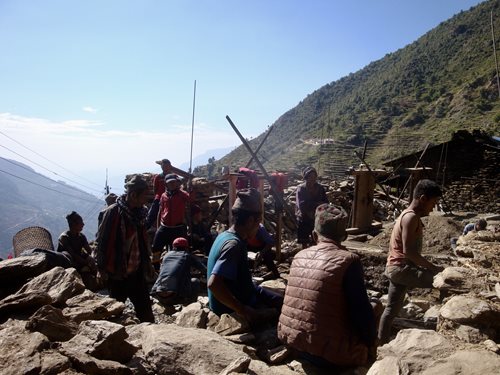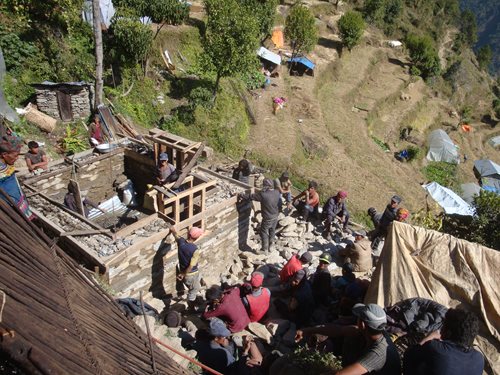On 25
th April 2015, an earthquake of magnitude 7.8 lasting less than a minute devastated the central part of Nepal. Nearly 9000 died and around 22,000 were injured. In the worst-affected mountain villages more than 90% of homes were reduced to piles of rubble. It took days for rescue services to reach rural communities. In Kathmandu 600,000 buildings disintegrated or were rendered unsafe and only fit for demolition. An estimated 3.5 million people were made homeless by the earthquakes in Nepal.
There was a second earthquake on 12
th May, further east in Dolakha, of magnitude 7.3. This, along with innumerable significant aftershocks, brought down more buildings, many of which had been weakened by the first quake.
Efforts to mitigate the disaster were huge and as part of this the government of Nepal through their National Reconstruction Authority (NRA) offered funds to rebuild homes. Earthquake-affected victims first needed to apply to be added to an approved list so that grants could be offered from government funds. According to figures published by the Housing Recovery and Reconstruction Platform in April 2021, 851,260 householders were judged eligible and 811,754 enrolled. A design then had to be approved by the municipality; mostly this meant that the house would be built of stone or bricks and with rings of reinforced concrete at several levels within the walls. The roof was usually of corrugated iron.
Payments were made in three tranches and aimed to help with building an earthquake-resistant house but the NRA money was only sufficient to cover the cost of a very small one or two-room house. Even so, 810,635 householders received their first tranche of money amounting to NRp.50,000/- or about £300.
Even with this support rebuilding wasn’t straightforward. The standard NRA-approved designs allowed for the use of locally quarried stone and sand but even transporting such materials to the construction sites was a great deal of work and some injured or frail householders had great difficulty managing (see, for example, Shreeman's story by clicking
Life is a Little Easier). Many had to employ labouring help, although in some communities, co-operatives were set up and everyone contributed what they could.
Once foundations and the wall-bases, including a damp proof course, had been built then an NRA engineer visited and approved them for the next tranche of money which is 150,000/-; 703,430 householders received this.
There was a further engineer check when the house completed before the final balance of 100,000/- was paid to the householder. Of this last tranche of money, 25,000/- was supposed to be used for a toilet, solar power or a biogas system; 637,902 households received this final payment; 63,269 others also were eligible for retrofitting grants, but only 456 have received these in full so far.
These numbers imply that some people had difficulties navigating the system or didn’t have the funds to complete the work they had planned or some other misfortune befell them. Even six years after the quakes, there are plenty of incomplete or damaged houses to be seen all over the region.
Part of the work that the
Purnima programme and its NGO partners and others have been doing is to help householders to complete their homes through administrative support, technical advice and supply of materials. It has been heartening to have been able to meet some of these beneficiaries and see how much this help has meant to them. Relatively small amounts of money have made an enormous impact on many lives here in Nepal and there is huge warmth towards the UK for supporting this work.
 |
| Women in Yarsa, Gorkha District, breaking stone to use as a base for new houses as part of co-operative rebuilding work after the earthquakes |
 |
| Community rebuilding in Yarsa, a couple of years after the earthquakes |
 |
| One of the rebuilding team in Yarsa |
 |
| Yarsa vilagers co-operate to bring in crops and also came together for rebuilding homes |
For stories from some of the people these schemes have helped click
Leaving No-one Behind